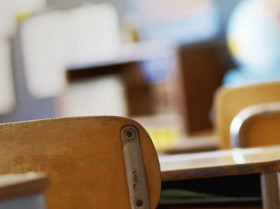The weather here in St. Louis has been more enjoyable this summer than in previous years, but the heat has arrived. With a heat index of 107° F, it’s not enjoyable to be outside from 3-5 p.m. Yesterday, my girls and I decided we would create an obstacle course in our formal family play room. As usual, I began thinking about the connections our actions had to education. I thought back to my years teaching elementary and middle school and remembered a few things:-
Students often walk while standing tall, in straight lines, from classroom to classroom.
Students often walk while standing tall, in straight lines, from classroom to classroom.
Students often walk slowly, from learning center to learning center, within a classroom.
Although most classrooms look a lot different than a decade ago, a few things remain the same. Students are to still required to walk ‘orderly’ (quietly) in hallways. It left me wondering why ‘orderly’ couldn’t be expanded to increase their fundamental movement competence? I researched this issue several years ago, and you can read the study published along with Dr. Anne Murray-Orr here. The primary conclusion that we drew from the study is that classroom teachers would love to support students’ physical literacy development, they just need more resources on how to do so.
Then, reflecting on Spark: A revolutionary new science on exercise and the brain, I can’t help but feel sad that we (education system in general) don’t provide classroom teachers with the resources necessary to help increase movement in their classroom. Naomi Hartl (@MissHartl) and I spoke about our shared passion for increasing physical activity in the classroom one evening this week via Google hangout. When I was a physical education professor I always wove physical activity into my classroom lectures, as I did when I taught K-12 health. My own girls’ obstacle course inspired me to share a few tips that you might implement in your home (if you are a parent), and/or in your schools (if you are a physical education teacher, classroom teacher, school administrator).
A few tips
- Make paths between learning centers using duct tape, poly spots, and/or gymnasium floor tape. Use different colors, patterns, and/or numbers to help reinforce content area objectives. Blue might represent moving on tip toes, for example - while green might represent moving at a medium level.
- Use gymnasium tape to encourage students to move along a straight or zig zag line at different levels and speeds or by hopping on one foot vs two feet, etc.
- Paint a hopscotch pattern or have a hopscotch rug. This would be ideal as students enter a classroom or learning space. I bought this for $15 off of amazon because I felt (a few years ago) my oldest should be more proficient at her one foot hop. I didn’t want to bug her to do it and simply put this rug down and every time I walked by, I would do the hopscotch pattern. Before I knew it, she was following suit, and hopping on one foot at mastery.
- Allow students to be creative in their challenges. Yesterday, it was their idea to grab some beanbags to determine if they could move along the beam with the beanbag on their head. Let’s give our students more voice, more choice, and a sense of autonomy! Research tells us that increased perception of autonomy = increased motivation to participate.
- Risk. Sure, the trampoline in the pics below is not for climbing, but if a child sees it as a climbing apparatus why would I want to squash that if she/he is developmentally ready to climb it? I get that we might not be allowed (for legal purposes) to have them climb this type of structure in school. But, let’s encourage it in our homes!
- Don’t think you have to go big or stay home. A big of paint and a few household items are all you need.
I think parents should be encouraged by teachers to purchase physically active toys for birthdays, etc. and teachers should be encouraged to use allocated funds to make their teaching spaces encourage movement. Teachers should check with district physical education coordinators, health promoting school leaders, and/or administration for funds to do this. A recent trend is to put some stationary cardio (adult-like) equipment in classrooms. While the intend is admirable, I think we can do a better job of meeting kids where they are and providing them something that is more - well - appropriate for kids. Many adults find cardio equipment boring, we don’t want to bore our kids and in turn, sway them away from physical activity.
Here are a few pics of the soccer player and Snow White who was pretending to be Spiderman. I’m sure they will come up with some new adventures this afternoon when I finish work!

- Setting up!

- Corey Hart’s song is going to be re-released to be “I wear my soccer stuff all day”.

- She thinks she has it mastered, and I love her confidence!
How about you?
How do you make your house movement friendly for yourself and/or your children?
How do you make your classrooms more active friendly?
How do you support your classroom colleagues in making their learning spaces more active friendly?





